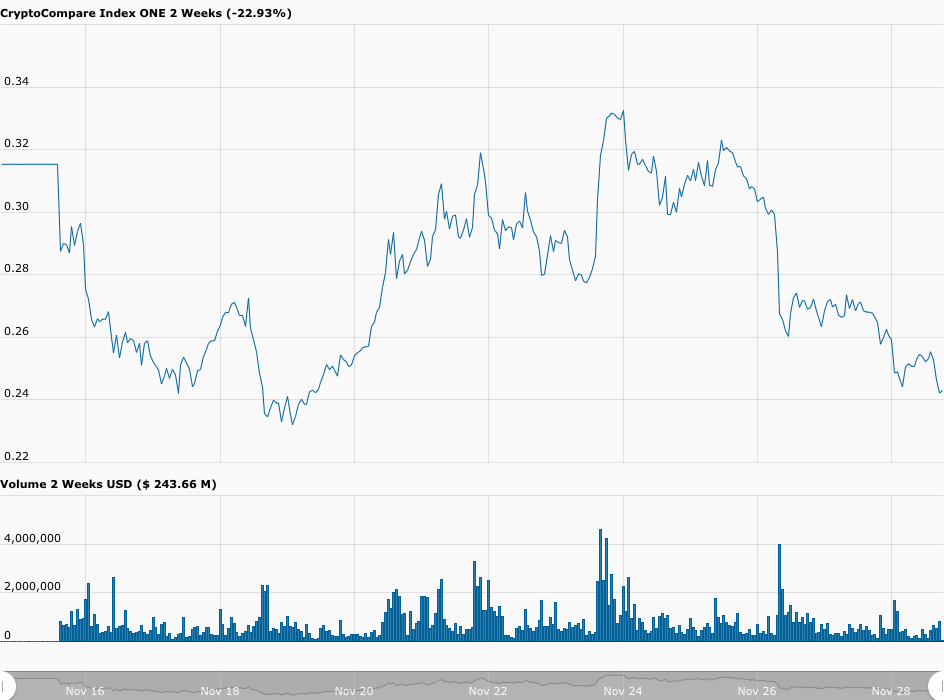Recently, crypto influencer “Coin Bureau” (“@coinbureau” on Twitter), talked about a layer one (“L1”) blockchain project that has a chance in future to “become a top contender for the king of smart contract cryptocurrencies”.
In a video released on his YouTube channel “Coin Bureau“ on November 23, the show’s pseudonymous host told the channel’s subscribers that $ONE, the utility token of blockchain Harmony, could be “the one coin to rule them all”.
What Is Harmony ($ONE)?
Here is how Binance Research describes Harmony and its native token:
- “Harmony is a fast and secure blockchain for decentralized applications. Harmony’s main focus is on achieving scalability by dividing not only the network nodes but also the blockchain states into shards, ‘scaling linearly in all three aspects of machines, transactions and storage’.
- “Harmony’s sharding benefits by Verifiable Random Functions for secure and random state sharding. The consensus mechanism of Harmony, Effective Proof-of-Stake, innovates on Practical Byzantine Fault Tolerant consensus mechanisms to further reduce centralization, while supporting stake delegation, reward compounding and double-sign slashing.
- “Its utility token, ONE, is running on Harmony’s mainnet since June 2019 and is prospected to reach an annual inflation of 3%. The token must be used as stake for network validators and is required to initiate transactions.“
According to a FAQ-style blog post Harmony published on 23 April 2019, the blockchain startup “helps businesses build marketplaces of fungible tokens (energy credits, security offerings) and non-fungible assets (game collectibles, real estate).” Also, it is working on “zero-knowledge proofs for data sharing (ad exchanges, credit ratings) while preserving the consumer’s privacy.” Harmony hopes that its fast and secure blockchain architecture will eventually be able to support billions of users participate on decentralized marketplaces.
The Harmony token has various uses on the Harmony network:
- Staking so that you can become a validator in order to earn block rewards and transaction fees.
- Paying transaction, gas, and storage fees.
- Voting (on-chain governance of the protocol).
Harmony held the first public sale of its native token on initial exchange offering (IEO) platform Binance Launchpad in May 2019.
Why Coin Bureau Is Bullish on $ONE?
According to a report by The Daily Hodl, here are a few highlights of comments the Coin Bureau host made about Harmony and $ONE:
- “Harmony looks like Ethereum 2.0 under the hood. This is because Harmony leverages the Ethereum Virtual Machine (EVM) for smart contracts and uses a sharded proof-of-stake blockchain consisting of four shards. Each shard can process up to 500 transactions per second, meaning Harmony can currently process around 2000 transactions per second, with a transaction finality of 2 seconds.”“
- “Apart from staking, the ONE coin is used for governance and to pay for transaction fees…When it comes to transaction fees, all ONE coins used to pay for transaction fees on the Harmony blockchain are burned. However, ONE is not deflationary. This is because a fixed supply of 441 million ONE coins are minted every year, and ONE coin transaction fee burns are designed so they only burn the ONE coins that would otherwise be minted.“
- “… ONE coin should have an easier time reaching new all-time highs. And my long-term technical analysis suggests it could hit $0.50 later this year or early next year.“
- “If Harmony can successfully attract the devs it needs to meet its milestones, the ONE coin could become a top contender for the king of smart contract cryptocurrencies.”
$ONE’s Price Action
According to data by CryotoCompare, currently (as of 18:05 UTC on November 28), $ONE is trading around $0.2428, down 8.93% in the past 24-hour period.

Disclaimer
The views and opinions expressed by the author, or any people mentioned in this article, are for informational purposes only, and they do not constitute financial, investment, or other advice. Investing in or trading cryptoassets comes with a risk of financial loss.
Image Credit
Featured Image by “Robertgreene674” via Pixabay









